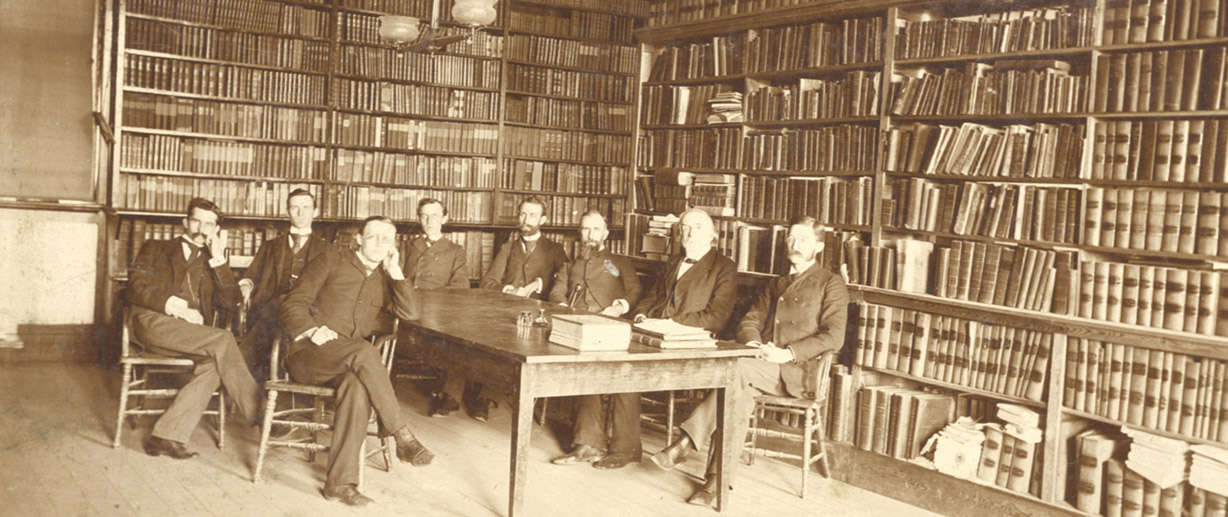By Dr. Phillip Stone ’94, college archivist
When Edward C. Jones designed Main Building, he included space for the college’s library. For most of the college’s first 60 years, a second-floor room housed the college’s growing collection of books and periodicals. A member of the faculty served as the librarian, and professors often donated books to the collection.
The college’s two literary societies also maintained libraries for the use of their members. Around 1894, the societies turned over their books to the college library. In that decade, the college finally hired a librarian to manage the collections. The addition of the literary society libraries meant that, by 1897, the library had expanded into a second room on the second floor of Main Building. But as the curriculum changed, and as the faculty and student body grew, the library needed to grow as well.
By 1910, the college had plans to build its first freestanding library. With a gift from Julia Smith, the daughter of Wofford’s original English professor, Whitefoord Smith, and additional funds raised by President Henry N. Snyder, the college built the Whitefoord Smith Library (now the Daniel Building). This library contained more space for books as well as a large, traditional reading room for student use. The 1910 College Catalogue noted that the library held about 20,300 books, not counting a large pamphlet collection. The building had enough shelving for about 35,000 volumes and expansion space for another 17,000 books. The reading room had space for about 70 researchers. The building itself was designed with heating, lighting and shelving appropriate to that day’s standards for care of books, and the collection was cataloged using the Dewey Decimal System, reflecting the growing professionalization of libraries.
In the years after World War II, the college entered a period of growth, and the library needed to expand again. The college added a wing on each side of the building, which provided space for more books, more researchers and some new (for the 1940s) technology. One wing housed a new reference room with additional study space. The other included a projection room for showing films to classes or groups, space for listening to audio recordings, and a treasure room, the predecessor of today’s archives. The renovation also replaced the wooden floors with fireproof concrete. Following the expansion and renovation, the library could seat around 250 readers and housed a collection of about 48,000 books and bound periodicals. The building’s estimated capacity was close to 85,000 books. Faculty used the new projection room to add audiovisual instruction to their courses.
That renovation served student needs for the next 20 years, but by the mid-1960s, the space was becoming inadequate. Its print collection had grown to around 87,000 volumes, and its seating capacity had declined. With around 1,000 students on campus and a changing faculty, the 13,000-square-foot library was out of capacity. Students began campaigning for a new library, even running a frontpage story in the Old Gold and Black with the headline “We Need a Library!” The college began plans for a threefloor, 43,000-square-foot structure soon afterward, and the Sandor Teszler Library opened in August 1969. It was dedicated in honor of Sandor Teszler in 1971. When it opened, the $1.5 million facility had a capacity of 150,000 volumes and could seat considerably more researchers than its predecessor.
The current library has proven its capacity for flexibility, which is fortunate since the needs and expectations of library users have changed considerably over the past 54 years. The library had not entered the digital age when the building opened, but the landscape for libraries is quite different today from what it was in the early 1970s. Libraries have moved from being focused on storing books to being places where the user experience is central. Today, Wofford’s Sandor Teszler Library provides access to 119,000 periodicals and 900,000 books in electronic formats as well as a floor of print books. Perhaps the best thing about these electronic formats is that students can access them anywhere, even when they are studying abroad.
Archives and special collections have become part of this digital transformation as well, both by collecting materials that are in electronic formats and by digitizing books and papers to make them available to researchers around the world. Even with increased digital resources, the library is still a popular place to study and do research — maybe even more so with a self-serve coffee bar, the Wofford Writing Center, presentation creation and practice spaces, and personal librarians who are eager to work with students.
Academic life at Wofford is different than it was in 1854 or 1954, but the focus on the liberal arts education and on excellence in undergraduate teaching has remained constant. In 2023, the Sandor Teszler Library is still focused on student success by providing a thoughtfully curated collection of academic resources for students, staff and faculty.
